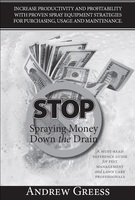Clean it Out to Prevent Problems
Posted by Andrew Greess on May 26, 2015
Do not wait until the busy season to realize you have yet to do your maintenance. Use a slow or off seasons to get spray equipment in fighting shape for the long hours and hard use it will undoubtedly endure. Taking a little time to prepare will reduce downtime during your critical busy season, as well as help reduce equipment repair expenses by fixing small problems before they become big ones.
The first thing to do is give your tank a good cleaning. Tanks often experience a buildup of chemical residue caused by pesticides falling out of suspension and accumulating on the bottom of the tank. This causes various problems.

- The buildup can affect the concentration of the material you’re applying. For example, if the water in the tank is low and some of the residue came free, you could be applying material at higher than label rates. Alternatively, you could be inadvertently applying a different chemical from an earlier mix.
- When residue comes free, it clogs filters, hoses, guns and tips. All of these outcomes are negative and will affect equipment availability, technician productivity and repair expenses. Clogged equipment will cause your technician to lose time and could potentially destroy the pump.
- The clean-out process will remove other dirt, rock and debris that accumulate in the tank, which will play havoc with downstream components.
Following are thoughts for cleaning out a tank:
- Empty the tank as much as possible without running the pump dry.
- Fill the tank with clean water, and run it through the system. Remove the spray gun so it doesn’t clog. Periodically check the filter to be sure it doesn’t clog. Be sure to follow all applicable laws when dealing with the rinsate. If you don’t have a good place to spray the rinsate, spray it into another tank on a different truck.
- Add clean water to the tank. Don’t fill the tank. Add just enough water to feed the pump and fill the hose. Most of the tank should be visible. Turn up the pressure on the system, and use the spray gun to pressure wash the inside of the tank. Add more water, then spray the rinsate as above.
- Fill the tank with water and add tank cleaner, which is available from a chemical supplier. Most of these products use 1 pound of tank cleaner per 100 gallons of tank volume. Put the spray hose end into the tank, and let the system circulate the tank cleaner per the label directions. This will remove any remaining chemical residue. Properly dispose of the tank cleaner rinsate.
- Run another tank of clean water through the system to remove any remaining tank cleaners
- There might be debris remaining in the tank after you’ve finished the clean out. This could be stones, bottle caps, etc. Manually remove this debris so it doesn’t cause problems later. If the filter is at the low point in the system, it might be easiest to remove the filter, then use a garden hose to wash debris out of the tank, then out through the filter.
- Finally, check and clean the filter to ensure it’s free of debris and ready for the busy season.
A clean tank is a good tank. A little effort will be repaid in reduced downtime and fewer, less expensive equipment repairs. Spend time now preparing the equipment so it can contribute to the company’s bottom line this summer.
Qspray is your trusted resource for professional pest control and landscape equipment, parts and supplies. Learn more about Qspray today.

